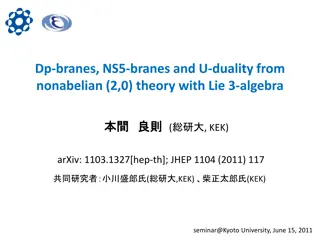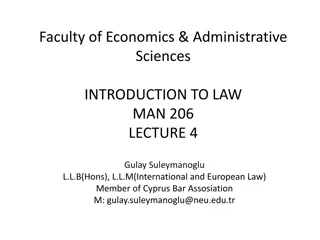H.L.A. Hart's Theory of Law: An Overview
H.L.A. Hart's theory of law, as outlined in his book "The Concept of Law," presents a unique perspective on the relationship between law and morality. Hart's concept differs from earlier legal positivist theories and he categorized later positivism into Inclusive, Exclusive, and Interpretative groups. He critiques Austin's command theory, explaining the distinction between being obliged and having an obligation in the context of laws. Hart emphasizes that laws can confer powers and privileges, not just impose duties, and society is governed by rules, according to his perspective.
Download Presentation

Please find below an Image/Link to download the presentation.
The content on the website is provided AS IS for your information and personal use only. It may not be sold, licensed, or shared on other websites without obtaining consent from the author.If you encounter any issues during the download, it is possible that the publisher has removed the file from their server.
You are allowed to download the files provided on this website for personal or commercial use, subject to the condition that they are used lawfully. All files are the property of their respective owners.
The content on the website is provided AS IS for your information and personal use only. It may not be sold, licensed, or shared on other websites without obtaining consent from the author.
E N D
Presentation Transcript
HARTS THEORY OF LAW Presented by: Rinkey Sharma Assistant Professor of Law IILS
BACKGROUND H.L.A. Hart concept of law is much more different from the theory of Bentham and Austin. Later positivism developed during the phase of 1900s. Later positivism can be divided into three groups: Inclusive Legal positivism: the main advocate of Inclusive Legal Positivism is H.L.A. Hart. The central idea of inclusive legal positivism is that morality can be a part of a legal system with the approval of the sovereign. In other words, they believed that law and morality are different but still morality can be a part of a legal system only with prior approval of the Sovereign. Exclusive Legal Positivism: the main advocate of Exclusive Legal Positivism is Joseph Raz. The main idea of Exclusive Legal Positivism is that there is a complete separation of law and morality. Interpretative Legal Positivism: the main advocate of Interpretative Legal Positivism is Ronald Dworkin. It believed in the idea that morality can be a part of a legal system or law only through the interpretation of judges.
HARTS CONCEPTION OF LAW Hart has given his conception of Law in his book The Concept of Law which was published in 1961. Hart does not provide any particular definition of the term Law. His theory is much based on a legal system prevalent in a society. Austin s theory of law became a base for Hart s concept of law. In fact, he wrote his book by making Austin s theory of law a base. He commences his book by criticizingAustin s view of law as a command. Austin proposes that all laws are commands of a legally unlimited sovereign. Austin said that all laws are coercive orders that impose duties or obligations on individuals. However, Hart says that laws may differ from the commands of a sovereign because they may apply to those individuals who enact them and not merely to other individuals. For Example: Laws enacted by Parliament in India. Those laws are applicable not only to the citizens of India but also bind the Members of Parliament who had enacted those laws.
He again said that all laws cannot be regarded as coercive orders as there are laws that confer powers and privileges rather than being coercive. For Example: Right to freedom of speech and expression, right to enter into contract etc. Further, he explained the weakness of Austin s theory of law with the help of an illustration, i.e., Gunman s case. A gunman order B to hand over his money and threatens to shoot him if he does not do so. In this case, B is obliged to hand over the money but he has no obligation to do so. B believed that some harm or other unpleasant consequences would befall him if he did not hand over the money to the gunman and he handed over the money to avoid those consequences. Hart says that Austin has failed to explain differences between being obliged (forced) and having an obligation (duty). Here, the order of Gunman cannot be regarded as law because B has been obliged (forced) to handover the money but he has no obligation (duty) to handover the money. However, law imposes certain duties on the individual and the individuals are under obligations to obey the law. Thus, he distinguished between being obliged and having an obligation .
SOCIETY BASED ON RULES Hart believed that human society is based on Rules . These rules are divided into Primary rules and Secondary rules. PRIMARY RULES Primary rules impose duties or obligations on individuals. Primary rules directly govern our behavior by stating what we ought to do and ought not to do. People obey primary rules not due to the threat of punishment but because of the fact that they have given their consent to bind by such obligations. Primary rules are binding because of popular acceptance. The function of primary rule is to preserve social order. Example: the law requiring us to stop at red light. We follow this because we wish to follow this rule. This rule is accepted by our inner conscience. These rules may be in the form of morality, equity, justice etc. According to him, the society based on these rules is primitive society and underdeveloped society. He regarded this as basic or Primary Rules.
He said that society based only on primary rules is defective and it suffers mainly from three defects: Static in nature: the primary rules do not change with changing circumstances. To change primary rule is to change the societal outlook towards particular rule which is not an easy and fast process. If it is to be changed then it needs to undergo a slow process of growth. Old rules cannot be replaced by new rules. Thus, hart regarded this as one of the defects of primary rules. Inefficiency: it means that there is no adjudicatory body to decide disputes as to whether a rule has or has not been violated. According to him, there is no special agency to deal with such matters rather they are left to the individuals affected or to the group at large to decide. This would ultimately lead to wastage of time.
Uncertainty: According to him, the important defect of primary rules is that they are uncertain i.e., one cannot identify a particular set of rules as primary rules. There may be situation where one accepts particular behavior as rules for other it might not be a rule. So, there is no standard on the basis of which these rules are to be ascertained. Since these rules are unofficial we cannot refer any text or official order to determine its certainty.
SECONDARY RULES They Confer power. They enable the legislators to modify their policies according to the needs of society. without such rules, the society would become very static. Power conferred may be private or public. These rules set up procedures through which primary rules can be introduced, modified or enforced. Thus, these are rules about rules.
According to hart, to remove the each defect of primary rules following three secondary rules are created: Rule of change: this rule was introduced to remove static nature of primary rule. This rule empowers an individual or body of persons to introduce new primary rules for the individuals and to eliminate old rules. Such rule of change may be very simple or very complex. It may be unrestricted or limited in many ways. The rules may define in more or less rigid terms the procedure to be followed in legislation. Rule of Adjudication: the defect of inefficiency will be remedied by secondary rules i.e., Rule of Adjudication which gives power to individuals to adjudicate the dispute and to decide whether a primary rule has been violated or not. It signifies the procedure to be followed the person empowered to adjudicate etc. Rule of Recognition: this rule was introduced to remove the defect of uncertainty from the primary rules. As said earlier, the rules of one individual may differ from other because there is no authoritative text which signifies that this rule is primary rule. So, the rule of recognition is nothing but a written form of rules. In other words, it a public document which contains a list of rules which is prevalent in society. It is on the basis of this rule of recognition that the validity of any rule depends in the society. In Hart s conception of law more prominence is given to the rule of recognition.
PRIMARY RULES (DEFECTS) SECONDARY RULES (REMEDY) Static Rule of change Inefficiency Rule of Adjudication Uncertainty Rule of Recognition
Hence, according to Hart the union of Primary rule with the secondary rule is the essence of law. In other words, the union of primary rule and secondary rule together forms a legal system. It makes a legal system complete and developed. Primary rule + Secondary rule = Legal system























